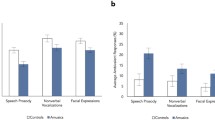Abstract
Children aged 3 to 4 and 7 to 8 years listened to eight tunes which were either in the major or minor mode and either unaccompanied melody or harmonized. For each tune children selected one of two schematic faces chosen to depict happy or sad facial expressions. Children 7 to 8 years old showed a significant major-happy and minor-sad connotation, which was also shown by adults. However 3 to 4 year-olds did not show any such significant association between musical mode and emotional response. Harmonic accompaniment significantly increased the frequency of happy responses. The results support the idea of a learned association between mode and emotional response.
Similar content being viewed by others
References
Buck, P. (1934).The Oxford nursery song book. London: Oxford University Press.
Crowder, R. G. (1984). Perception of the major/minor distinction: I. Historical and theoretical foundations.Psychomusicology, 4, 3–12.
Crowder, R. G. (1985). Perception of the major/minor distinction: III. Hedonic, musical and affective discriminations.Bulletin of the Psychonomic Society, 23, 314–316.
Crowder, R. G., Reznick, J. S., & Rosenkrantz, S. I. (1991). Perception of the major/minor distinction: V. Preferences among infants.Bulletin of the Psychonomic Society, 29, 187–188.
Cunningham, J. G., & Sterling, R. (1988). Developmental change in the understanding of affective meaning in music.Motivation and Emotion, 12, 399–413.
Dolgin, K. G., & Adelson, E. H. (1990). Age changes in the ability to interpret affect in sung and instrumental melodies.Psychology of Music, 18, 87–98.
Heinlein, C. P. (1928). The affective characteristics of major and minor modes in music.Journal of Comparative Psychology, 8, 101–142.
Hevner, K. (1935). The affective character of the major and minor modes in music.American Journal of Psychology, 47, 103–118.
Kastner, M. P., & Crowder, R. G. (1990). Perception of the major/minor distinction: IV. Emotional connotations in young children.Music Perception, 87, 189–202.
Kratus, J. (1993). A developmental study of children’s interpretation of emotion in music.Music Perception, 21, 3–19.
Lundin, R. W. (1967).An objective psychology of music (2nd ed., p. 168). New York: Ronald.
Scherer, K. R., & Oshinsky, J. S. (1977). Cue utilization in emotional attribution from auditory stimuli.Motivation and Emotion, 1, 331–346.
Smiley, P., & Huttenlocher, J. (1989). Young children’s acquisition of emotion concepts. In C. Saarni & P. L. Harris (Eds.),Children’s understanding of emotion. Cambridge, England: Cambridge University Press.
Terwogt, M. M., & van Grinsven, F. (1991). Musical expression of moodstates.Psychology of Music, 19, 99–109.
von Helmholtz, H. L. F. (1954).On the sensations of tone (4th ed.) (A. J. Ellis, Trans.). New York: Dover. (Original work published 1877)
Author information
Authors and Affiliations
Additional information
We thank the teachers and children of Mauldeth Road County Primary School and Ladybarn Primary School, Manchester, for their cooperation, and we thank Debra Raye and Daniela Milone for help with testing.
Rights and permissions
About this article
Cite this article
Gregory, A.H., Worrall, L. & Sarge, A. The development of emotional responses to music in young children. Motiv Emot 20, 341–348 (1996). https://doi.org/10.1007/BF02856522
Issue Date:
DOI: https://doi.org/10.1007/BF02856522




